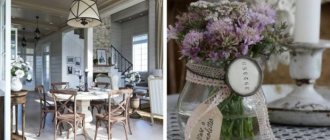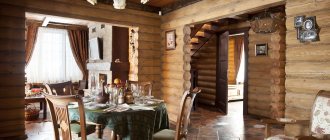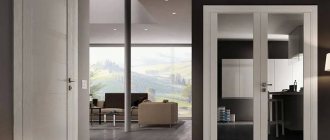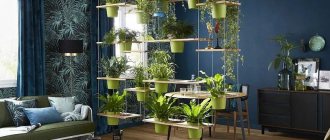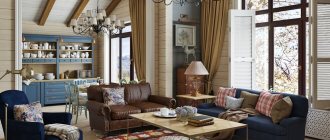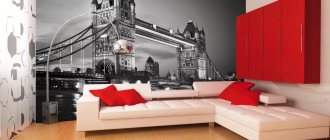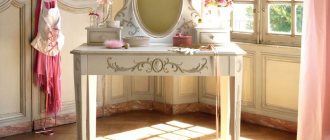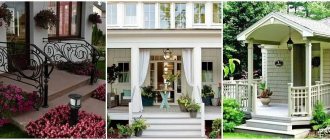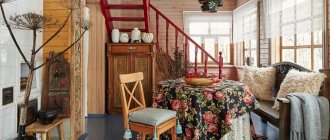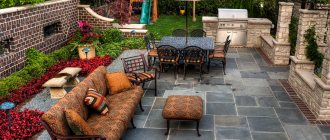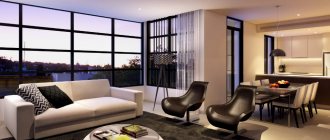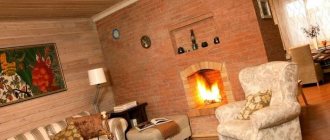The value of the works of ancestors is increasingly significant for contemporaries. And as one of the examples of respect for our great culture, the Russian style in the interior of the apartment began to be revived. The ideal embodiment of this direction would be a room with a stove, which would not be possible in a multi-storey building. However, you can always come up with something. And designers offer to decorate their home in Russian style. Of course, this is not at all an ideal correspondence to the canons, but it will still be beautiful, impressive, and with a Russian spirit, which modern, loft and other popular style solutions lack.
Main features of Russian style in the interior
This direction recreates the conditions in which people lived in Rus' in the 18th and 19th centuries. It clearly distinguishes two varieties.
The first is imitation of a peasant hut, which is characterized by:
- wooden floor, walls and ceiling;
- a large amount of textiles that look as if they were woven right there;
- lack of trinkets, except the simplest and most primitive - clay whistles, for example, or embroidered napkins;
- predominance of bright natural colors.
The living room will look like this: wooden trim, woven rugs on the floor, a heavy, roughly hewn table, benches. Perhaps a chest in the corner or shelves on the walls. No photographs or modern decorations - they stand out.
The second is imitation of the mansion of wealthy townspeople, which is characterized by:
- the same all-wooden finish, but carpets can be hung on the walls and the ceiling can be whitewashed;
- an abundance of textiles, but cleaner, perhaps even factory-made in appearance;
- the presence of trinkets that correspond to the spirit of the time and century;
- the predominance of the same natural bright colors.
The dining room will look different: whitewashed ceiling, carpet on the wall, fluffy carpet on the floor. The table is lighter, more elegant, covered with a tablecloth. Instead of benches there are chairs. There is a samovar on the table as a symbol of hospitality and crowded feasts. Paintings on the walls are allowed, as are framed photographs.
It is easier to implement the second option in an apartment: it does not contrast so much with multi-storey buildings.
Fabric is an indicator of style
Upholstery of furniture groups, pillows, curtains - you don’t have to make a long choice, because manufacturers offer ready-made collections. Sometimes even with names that help you make a decision: Firebird, Sadko. Paradoxically, Russian linen is actively offered by foreign companies, which once again confirms the relevance of this design.
All kinds of tablecloths, napkins for the dining area, lace decor, embroidery, tapestries, homespun rugs - those attributes that some time ago they dreamed of getting rid of as a relic of the past are actively represented in many design projects. Now they are considered entourage things, without which this style will look unfinished.
They encourage you to try to realize your creative potential in order to be especially proud of the final result in the future.
Decorating an apartment in Russian style
Decorating a room in the Russian direction is not so easy. Everything should be exclusively environmentally friendly and natural:
- wooden floors. In the "hut" - not varnished, just smooth, without a pattern. In the “mansion” you can put varnished parquet blocks, from which you will then need to form a pattern;
- wooden walls. Since it is impossible to really make them in a multi-story building, all that remains is to sheathe them with panels that will imitate stacked logs. Wallpaper in the Russian folk style is not welcome, although it can be pasted in the “mansion”. The design should be simple - a floral pattern works best;
- wooden ceiling. In the “hut” it is simply made of wood, in the “mansion” it is bleached. No modern materials are used.
Finishing is expensive, since wood is an expensive raw material. The design must be natural, despite the temptation to use plastic panels or linoleum that imitates wood. The fake looks worse and does not give off the specific smell of wood.
Box
Here it is worth talking separately about wooden chests.
Firstly, it is an aesthetic alternative to cabinets.
Secondly, you can sit on them and use them as benches.
They have also proven themselves well as food storage on balconies and loggias. They can be used to store bedding or seasonal items such as rugs and blankets, and they will smell great of natural linden, even if you take them out six months later.
In chests with easy-to-open lids and a mechanism against accidental closing (everything is possible with modern fittings) you can store deposits of children's toys, construction sets and other small items.
To collect toys after games, you can give your beloved child a shovel that is the right size, and then the tedious process will become fun and go faster.
Free place
In the Slavic style, the accumulation of objects throughout the entire area of the apartment is not welcome. There should always be free space for movement, convenient approaches to chests and beds, and for children to play in bad weather.
Designate shelves for displaying creative accessories, such as wicker baskets with balls of woolen thread or a niche for an easel so that it is out of the way when folded.
After eating, put the dishes away in their places, based on ancient beliefs, brownies are offended when their owners are sloppy and can do mischief. It is also advisable to get rid of storage on the balcony whenever possible.
Toys
The Slavs treated children's creativity with special reverence, and the first crafts often became an integral part of the interior: dolls lovingly knitted by girls from scraps of fabric, little men from twigs, dogs carved by the skillful fingers of boys almost from the moment they were entrusted with holding knives.
Now, in the fall, you can also collect dry fragrant straw from a field and make a lot of interesting interior items from it yourself or together with your children: bouquets, toys, straw panels, although you will have to tinker a little with drying the straw, strengthening it and cutting it.
But the resulting result will certainly exceed all expectations: you definitely can’t buy this from famous designers or in a hypermarket.
Charms
It makes sense to decorate the interior with amulets in reasonable quantities. Previously, many things that seemed like toys had a certain sacred and practical meaning.
For example, dried lavender and lemon balm were placed inside bedside beregin dolls to ensure a restful sleep. To consolidate the happiness of the newlyweds, they were always given lovebirds, these are rag dolls with one common hand, as a symbol of the strength of the relationship.
With a doll in his hands, the husband drove away evil spirits and other evil spirits from his wife, who was giving birth in the next room, drawing their attention to himself. Les, brownies and water creatures also often became objects of embodiment in toys: carved or knitted toys were decorated, wrapped with ribbons, and dried flowers woven into tufts of hair. The toys obtained as a result of such actions helped the owners in business, both inside and outside the house, attracted goodness and warded off the evil eye.
The Slavic style will appeal to many lovers of everything natural and pleasantly smelling. It is convenient in terms of equipping your home with appliances: just choose models with a wood-look finish. It is beautiful and tidy in general: cleanliness and convenience have always been valued by the Slavs, and the huts preserved by snow or marshy layers found by archaeologists are clear confirmation of this.
It’s pleasant to work and relax in such an interior, and the aromas of herbs and kind figurines of brownies will help you get into the right frame of mind.
Styling rooms in Russian style
To successfully decorate a room in the Russian style, it is not necessary to read historical studies and figure out what people in Rus' in the 18th century could use and what they could not. It is enough to be imbued with the spirit of the era, because stylization is not an attempt to turn a house into a reliable museum. Everything needs to be decorated tastefully and beautifully. The general requirements are simple:
- all modern materials should be excluded - wood should predominate, all furniture should be made from it;
- abandon modern decorations - photographs on the walls, factory trinkets, lamps that resemble spotlights should be absent;
- equipment, even in the office, should be hidden in built-in cabinets and cabinets, otherwise it will get knocked out.
If modern gadgets and household appliances are used constantly, it is inconvenient to take them out each time and then put them back, you can cover them with textiles: a napkin, an embroidered piece of fabric. The impression will not be spoiled, and it will be much more convenient to use.
Decoration and furnishings
Various types of wood, such as cherry, birch, ash and pine, vary greatly in both texture and budget, and real solid wood (especially oak) can seem hefty in price.
Lightening completely wooden surfaces is not only aesthetically attractive, but can also be practical.
Companion materials for surface finishing:
- Tiles. Finishing part of the wall in the fireplace area, culinary area of the kitchen.
- Bleached plaster will add light and space.
- Natural stone (granite, marble) - emphasizes the structure of wood.
Creative owners will love the idea of aging or resuscitating suitable designs themselves. Modern improvised means (there are even ready-made kits, for example, for decoupage), varnishes and paints with all sorts of effects (craquelure, patina) take the process to a new level.
They allow you to create on your own that very valuable antique object that gives the room a special flavor: a china rack, a chest of drawers, a wardrobe, a chest.
Advice. Think about not just niches, but screens and doors that hide the necessary equipment for complete compliance and harmony.
For a kitchen in this unique design, manufacturers have provided solid wood furniture (or so-called solid wood), which:
- they will hide behind their facades small and large household appliances that stand out from the concept;
- for the hood, the requirements are taken into account - the shape of the chimney or a special box that hides a modification that is no longer relevant.
- household appliances in retro style, calm colors with copper and brass fittings.
Living room in Russian style
The guest room can be decorated in Russian style. The type of “hut” is:
- a large wooden table in the middle of the room;
- two benches near the table, covered with embroidered pieces of fabric;
- woven rugs on the floor;
- no TV;
- interesting things hung on the walls like bunches of grass, horseshoes, straw dolls and similar little things that are associated with antiquity.
It’s good if there is a samovar - it can be electric, as long as it looks authentic.
In the "mansion" it is better to place chairs instead of benches, cover the table with a white tablecloth with a pattern, and place a gramophone or record player disguised as it in the corner. Hang paintings of classics on the walls.
It is advisable that there be a lamp stylized as a kerosene lamp above the table.
Key principles
The main principles of the Russian style are simple: any of us can understand them. Cultural traditions are very powerful, so most of the features that shape this direction are well known to us. But additional information will not hurt, because the arrangement of the bedroom interior should be based on the basic principles of the chosen design style.
One of the key features of Russian design is the dominance of materials of natural origin used for finishing living space, making furniture and decorative elements.
In addition to wood, textiles and ceramics are actively used in decoration. As for tree varieties, preference is given to species growing in our country. Oak, birch, pine, maple, and alder wood will allow you to create a presentable finish at a reasonable price.
Today, a large number of exotic materials are offered, which cost much more, and in most respects are not superior to more budget Russian ones.
But some still add variety through “imported” cladding, decorating the walls in Russian interiors with bamboo-based panels and red “meranti” wood.
When purchasing these materials, request a certificate confirming their compliance with environmental safety requirements.
This finish will have to be stylized as natural wood, recreating natural wood shades through additional cladding.
Among the main features of Russian design are:
- Environmental friendliness . When arranging interiors, practically no plastic is used.
- Natural look of textures . Wood is usually not painted, but simply varnished. Iron surfaces are also left in their original untreated form. Brass is considered the most popular metal in Russian interiors; tin and cast iron products predominate in the decor.
- Abundant use of textiles . For a Russian bedroom, a beautiful bedspread with characteristic patterns, chair covers, curtains, and napkins with embroidery are selected. Decorative pillows are also often used, despite the fact that they are not very suitable for this area. Our compatriots began to use them for decoration, following the example of the eastern inhabitants. If you like these types of textiles, complement the look of your Russian bedroom with them.
How to decorate a modern bedroom in ethnic style and what thematic decor elements and finishing options to use: ready-made examples with beautiful interiors.
You can see a large selection of photos with rustic bedroom interiors in this article.
Bedroom in Russian style
There were no bedrooms in the peasant hut; everyone slept on the stove or on benches in a common room. And since it is unusual for a modern person to relax on a hard surface, it is better to stylize the room immediately as a “terem”.
It is necessary to place a bed in the middle of the room (a large one, perhaps with a carved or metal back, always with a lush feather bed, an abundance of pillows and an embroidered bedspread on top, you can use a canopy). You also need to put a table and a chair next to it, a mirror where you can put yourself in order, a large carved cabinet with things, and hang a picture on the wall. You can place a table by the bed, and on it - a candle in a candlestick.
Furniture
Tiles are also used to decorate furniture. Similar elements can be present at the head of a massive bed - the central piece of furniture in the bedroom, in the design of a coffee table and chest of drawers. They are often used to decorate walls.
But antique tiles are not so easy to find; in this case, you can resort to imitation. Modern manufacturers offer collections of small tiles with an antique design - with a network of cracks on the front side.
The Russian style has features of ethno-direction and historical design, so it could not escape the influence of time.
Surfaces with signs of aging, slightly peeling paint, wood worn to a shine - all this is typical for furnishings in a Russian bedroom. Thanks to these details, the atmosphere of past years is created.
The interiors, decorated in the Russian style, are practical and functional. Make sure to keep the room layout simple and understated. Use only the most necessary furniture. If desired, the Russian style can be successfully recreated even in a small bedroom.
To unload the space, it is recommended to replace a massive closet with presentable chests made of wood. Many years ago, in Russian huts they were used for storing things.
Chests with a straight lid can serve as additional seating, as a replacement for a cabinet or coffee table.
Interesting! In ancient times, the huts were made of wood, fires often occurred, so all valuables were stored in iron chests. When there was a fire, they were taken by the side handles and carried out of the burning house. Today the chest has become the highlight of the interior.
If you couldn’t find a real chest, replace it with a chest of drawers or a cabinet of a similar shape - today many manufacturers offer similar products.
Due to the furnishings, hand-decorated with painting, the room will acquire individuality.
In addition to a bed with a wooden headboard, small nightstands, a coffee table and chairs with high backs, we recommend purchasing a couple of wooden footstools for the bedroom.
If you think that you cannot do without a closet, we recommend choosing a built-in model with mirrored or wooden doors.
The brightest and most spectacular ideas for bedroom design in a marine style: a large photo gallery of interiors with options for finishing, renovation and decor of modern bedrooms.
You will find the most beautiful examples of Greek-style bedrooms in blue tones here.
Ways to recreate the Empire style in the bedroom can be studied in the article at:
Children's room in Russian style
In this style solution, the children's room looks like a bedroom. The only difference is the chest with toys, which needs to be placed somewhere in a visible place.
If the child is still small, then you need to buy not a regular bed, but a cradle. It should be wooden and swing when pushed. Above the bed you can hang a structure made of glass stylized animals - in the 19th century this would have been a real luxury.
The lighting is still the same - with an imitation of antiquity.
Features of a Russian estate
The Russian estate has become a separate phenomenon in architecture and interior design. And now many owners of country houses are trying to reproduce this trend. Let's try to figure out how a Russian estate differs from ordinary mansions, take a little dip into the past and consider the features of such an interior.
The artist Stanislav Zhukovsky is known for his paintings in which he lovingly depicted ancient Russian estates. From his paintings you can study the interiors of houses from the mid-19th to the beginning of the 20th century.
Let’s immediately decide that we will talk specifically about estates, and not huts, towers and princely palaces. A lot has been said about huts and towers; this is also history, and more ancient. And nowadays only a few can afford to replicate the luxury and royal style of the palaces of Russian princes.
And who would decide to reproduce such a style - in modern realities it is difficult to imagine.
The Russian tower, as a place of residence for fairly wealthy families, can now be found mainly in ancient cities and villages. Carved platbands, wood as the main material, four small rooms around a solid stove, a veranda - these are the main differences of this structure.
The interior of a Russian hut can now be found in bathhouses; sometimes people who are fond of antiquity build dachas this way. Everything here is simple, rustic, without frills or unnecessary details.
So, having dealt a little with the towers and huts, we move directly to the estate. The name comes from “to plant” or “to plant.” An estate is traditionally understood as a country building, an entire complex, which, in addition to the residential building itself, includes outbuildings and an extensive garden. It is customary to distinguish the following types of estates:
- Boyar or merchant estates that began to appear in the 17th century.
- Landowner estates, which remained the main place of residence for wealthy Russians until the beginning of the 20th century, gained particular popularity in the 19th century.
Baron Nikolai Wrangel (brother of Pyotr Wrangel, leader of the White movement) went to the provinces in 1902 to study in detail the features of the estates of the then landowners. This is how he described a traditional estate in his book: “White houses with columns, in the shady thicket of trees; sleepy, mud-smelling ponds with white silhouettes of swans plowing through the summer water...”
A white or sometimes blue house in a classical style, columns with Corinthian orders, a maximum of two floors, a wide porch or terrace - this appearance of a Russian estate is not outdated even now.
This photo shows the Galsky estate, located in Cherepovets. Now it is a house-museum telling about the life of landowners of the early 19th century.
As for the interior of Russian estates, one should distinguish the merchant style from the later one, created under the influence of European, mainly French trends and closer to modern realities.
These photographs show the house of the merchant Klepikov, located in Surgut. You can clearly see the abundance of textiles, very simple decoration, plank floors, and high-quality wooden furniture. We are sure that many of you have found such a metal bed with springs at your grandmother’s in the village. Let us turn again to Baron Wrangel, who described the interior of the estate as follows:
“Inside, in the rooms, there are decorous comfortable chairs and armchairs, friendly round tables, endless sprawling sofas, wheezing clocks with a rusty bass chime, and chandeliers, and candlesticks, and sonnets, and screens, and screens, and pipes, pipes ad infinitum.” .
The furniture in such an estate was often mismatched - an old chest inherited from the grandfather could sit next to a newfangled French chair or an English armchair, which the owner of the house, at the whim of his wife, purchased during a trip to the city. Traditionally, a Russian estate had a hall for receiving guests and, if the size of the house allowed, balls, as well as an office, which became the owner’s men’s refuge.
This photo shows the interior of an estate built in the village of Copper Lake (near St. Petersburg) by architects Elena Barykina and Slava Valoven for collectors of antique furniture. Almost all the furnishings are authentic, but there are also modern replicas in this house, created in an antique style.
If you want to recreate the interior of a Russian estate in your home, you should adhere to the following principles:
- A mandatory element will be a wooden floor, possibly parquet or planks.
- The furniture is laconic, preferably made of dark wood, with thin legs.
- The interior doors and baseboards are white.
- The walls can also be wooden, painted in neutral shades (but preferably snow-white). You can also use antique wallpaper that imitates textiles.
- Tables are round or oval, with beautiful tablecloths, lamps with cozy lampshades and light curtains.
As for the kitchen and bathroom, it is advisable to use tiles here. The doors of kitchen cabinets can be left wooden or painted like Gzhel, as in the example we presented.
Separately, it should be mentioned the influence that the Empire style or late classicism, which came from Europe, had on the interior of a Russian estate. Within the framework of the landowner's estate, this direction was called “rural empire”, becoming less pompous and luxurious.
Now some homeowners imagine the style of a Russian estate as a kind of mixture of hut, country, chalet, rustic and modern motifs.
Well, the style of the Russian estate has always been a kind of mixture of different directions, taking a lot from the classics and history of our country.
However, if you adhere to the main canons, in the end you should end up with a light interior, not overloaded with furniture, cozy, fresh, quite simple and at the same time truly homely, a real Chekhov’s dacha, described more than once by the classics of Russian literature.
Kitchen in Russian style
It is more difficult to arrange a kitchen in an old Slavic style in an apartment than in a village house. No matter how authentic the design and decoration may be, they will always miss the traditional Russian stove.
This can be solved by decorating the kitchen with a fireplace or stove. This is roughly what people do who want to decorate their apartment or studio in a country style.
Otherwise, the elements are unchanged: simple wooden furniture, old Russian trinkets, not too much light. Be sure to use textiles.
Lighting is important and necessary
This can become a serious problem if the interior involves permanent residence. The abundance of wood does not have the best effect on the level of illumination - surfaces, especially those not alternating with white plaster, absorb rays of light, making the interior a little gloomy, especially in an apartment with low ceilings.
What you should pay attention to in this case:
- The presence of large windows that will not allow the interior of living rooms to turn into a bathhouse.
- Lightening areas with paint, whitewashing, because white reflects light better than others.
- Active LED lighting, which saves interiors from dim lighting, is excluded.
The following will help you avoid disturbing the authentic atmosphere:
- perforated lampshades simulating lace;
- lampshades with painting and embroidery;
- birch bark lampshades;
- imitation of candles, lamps.
For modern reading, designers have come up with enough solutions. For example, the latest trend is lamps resembling a matryoshka doll made of metal and glass. Even special retro wires can become an interesting accent, allowing historical achievements to be justified.
Advice. In the windows, all plastic elements must be replaced with wooden frames and supplemented with decorative shutters, if desired.
The curtains compensate for the simplicity of their forms with an ornament of flower garlands; lace ruffles are possible. Cornices, certainly wooden, with skillful carvings, will become an additional decoration.
Hallway in Russian style
Historically, in the layout of the hut and tower there was no hallway - only a vestibule, where felt boots, an old snow shovel and similar things usually stood. Therefore, you have to simply decorate the hallway “a la Russe”. Wood trim, wall clock, wooden hanger. Simple design with Old Slavonic chic. You can attach a panel to the wall, cover the window, if there is one, with a patterned curtain or curtains. You also need to come up with other interesting ideas for interior solutions.
Varieties
When decorating a house or apartment using Russian traditions, you can give preference to certain types of style. They do not have a clear designation, but here it is important to choose what your soul gravitates towards. Will it be a minimalist old Russian interior, Russian-folk interior using elements of folk art, or will you want to recreate the image of a Russian estate or tower. All these nuances need to be taken into account.
In the case of a Russian hut, it will be enough to decorate the room with wood. Of course, the house should also resemble a hut from the outside - log, with shutters. Then it will all look harmonious.
In this case, a minimum of wooden furniture can be used in the premises, including tables and benches. Don't forget about the oven. This is the main highlight.
Folk art most often finds its embodiment in decoration. The same wooden furniture will be present, but bright accents can be placed using textiles - towels, tablecloths, rugs, curtains. All this should ideally be handmade. In such a room, painted wooden dishes and a samovar would be useful, and various amulets made from natural materials and improvised means would look organic. In one of the rooms a balalaika or accordion may be in place.
When reproducing the interior of a Russian estate, it is worth adding a touch of luxury. Here, in addition to wooden trim and expensive furniture, there may be a variety of decorative elements in the form of paintings, curtains, figurines, and carpets. The upholstery on furniture - armchairs and sofas - can be made of leather, suede, tapestry. In this case, the fireplace will become the central accent in the house.
Bathroom in Russian style
And even the wealthiest citizens did not have bathrooms in that era. Therefore, all that remains is to furnish a modern bathroom with references to a bathhouse: wooden trim (no wallpaper, tiles), crafts on the shelves, a fluffy broom on the wall, a bath cap on a hook. You can even put a home sauna in the bathroom - this, of course, will require permission to repair and change the layout, but it will fit perfectly into the style and will give you the opportunity to relax and improve your immunity at any time.
Shade range
Russian decor is characterized by a rich palette of shades. It is difficult to say which colors are not used in the design. You only need to avoid eye-catching neon shades. It is recommended to give preference to natural colors.
In such interiors, black is often combined with scarlet and gold, the red-green combination is diluted with blue, blue is used in a duet with snow-white. Another good selection is black with orange and amber.
Each region of our huge country has its own popular color combinations. They are combined into a solid palette, you just have to choose the shades to your liking.
Interior of a country house in Russian style
Here you can give free rein to your imagination. Today, designers offer various interiors for a wooden house in the Russian style. It is easier to arrange it than an apartment. If only because you don’t need to decorate the walls with wood, you can just use what you have. There is absolutely no need for a stylized fireplace here. What is important is a real Russian stove, designer painted and decorated. It will look great in photos and can be used for cooking. It sets the tone for the interior and serves as decoration for it. And it is advisable to decorate the rest in the same way as in the apartment: a lot of decor, folk painting, benches instead of chairs, a kind of rural chic.
The main thing is to know when to stop. Do not overdo it with decorative elements and do not turn your country house into a small national museum.
Modern Russian style in the interior personifies long-standing culture and traditions that have survived to this day. When choosing this style solution, it is necessary to properly decorate the room: use natural finishing materials, hide all household appliances, etc. Everything must be done with taste, then the interior will reflect the character of the owners, help them relax and recuperate.
History of the Slavic style
The Slavs built houses from high-quality wood material. It was pleasant to be in them, they kept warm, dry and pleasant aroma. Freshly cut hay was used as filling for the blanket and pillow. Rich houses could afford to fill them with soft goose feathers.
The site for building a house was selected according to certain criteria. In the spring the plot was sown with wheat. If we saw a good harvest in the fall, we realized that this place was suitable for construction. The logic was simple, wheat would not grow on clayey or too wet soil, which was a poor foundation for a house. At that time, they had not yet learned to calculate good places for construction using the scientific method and used folk wisdom, which coped with its task very well.
Home
No style accommodates such a diverse range of designs for stoves and fireplaces as Russian. In addition to the aesthetic superiority from the presence of this immutable attribute, in modern design the home includes additional functionality - zoning, especially with a combined kitchen-living room layout.
But for each direction you should adhere to the following recommendations:
- Russian hut is an imitation or a real version of an ancient whitewashed stove. An indispensable rustic touch is the firewood rack;
- Terem - tiles, and some collections are represented by extremely reliable aged copies, excluding the appearance of a remake;
- Russian estate - the fireplace portal can be made of stone; A potbelly stove is a non-trivial option.
No less important are the accompanying items of the fireplace area - copper products imitating bark, all kinds of forged accessories.
Architectural features
- Form.
Despite the traditional rectangular shape of the building itself, the rich stucco molding significantly transforms the appearance of the mansion. For the interior, the main characteristic is “baroque” and a richly furnished appearance. - External "accessories".
Decorating cornices, for example, with samovars, vases with flowers and various “curls” is a classic version of Russian merchant baroque. Attic pediments in a lush and wavy design are a frequent “showcase” of beauty. - Color.
As a rule, houses were painted red, terracotta, brown and ocher. You could also often find emerald and green shades of the walls. All stucco work on the façade was whitewashed or painted in a light gray color scheme.
The most characteristic manners of the merchant style:
- a combination of baroque “curly” motifs and ancient Russian ones, there are unique local architectural solutions;
- the framing of windows (including cornices and pediments) is characterized by floridity, pretentiousness and unconventional techniques, the complete opposite of the classical and strict style;
- the tastes of the merchant class took the form of the so-called “third Rococo”, which is characterized by a peculiar theatricality;
- pomp and originality.
Improved variation - tower
The dacha is now associated with pleasant moments, the opportunity to relax, and take a short trip. It’s not difficult to take an excursion into history, because changes and improvements are precisely aimed at enjoying the flavor without interrupting a comfortable pastime.
The upgrade applies to all wooden surfaces - they become smoother and carefully finished. Varnish, polishing, painting are allowed; parquet appears. The emphasis is on exquisite, fine carvings and ornaments. Mosaic design is present in the decoration of walls and floors.
Decorative elements also undergo changes for a more spectacular transformation:
- items are carefully painted;
- gilding, embossing - decorate many planes;
- clocks, paintings, mirrors on the walls no longer look like alien components;
- textiles - acquire delicate embroidery with decoration in the form of silver, gilded threads, beads, and pearls.
The furniture is more modern - even in the photo you can see the appearance of sofas, armchairs and those objects that, laconically fitting into the interior, are more familiar in everyday life. A simple shape, upholstery with a suitable fabric are signs that the soft group will take root in the design.
Elements of the “Russian hut”
The priority in a Russian hut is what is really necessary for life, what is natural and understandable, and decorations are secondary.
The pieces of furniture are bulky and necessary: chests, benches instead of sofas, shelves made of boards along the walls. A chest is the main piece of furniture: it is both storage for utensils and clothes, and a place to sleep. That’s why they are decorated with love, using forged elements, carvings, and stone tiles.
The indispensable attributes of the hut are a red corner for icons and a whitewashed Russian stove. The place of the red corner is the front free corner on the right; here an embroidered towel is hung, decorated with ears of wheat or artificial flowers, and a lamp is hung.
Household appliances should be hidden in special cabinets, like an old sideboard. Place a samovar with a pipe on a table or bench, hang a bunch of bagels (optional), arrange baskets and cupcakes. The shelves will be decorated with clay and wooden dishes and clay crafts.
Wooden objects will be in place: a hand spinning wheel, a butter churn. If there is an infant in the house, a cradle is suspended from the ceiling, and fishermen decorate the walls with homemade nets.
The estate is chic and original
A touch of chic without pretense of authenticity - this is how you can characterize the opportunity to create an original, spectacular, comfortable interior. The noble estate is a colorful classic style with regularity, symmetry, the use of expensive materials and objects - witnesses of a bygone era.
Folk traditions are quite consistent with the introduced foreign elements:
- It is quite acceptable to paint the ceiling, stucco molding, which is very effectively reflected in the ornament of the luxurious carpet on the floor;
- Wooden furniture, possibly with gilding, upholstered chairs;
- Upholstering walls with fabric or wallpaper that imitates it is a popular technique that adds coziness;
- Porcelain is everyday tableware, and exceptionally successful examples of plates are on the wall of the dining area as expressive decor;
- Complex baguettes, candelabra - measured, but very expressive;
- Floral and plant patterns are repeated many times.
Advice. In the concept of a Russian estate, Italian furniture, French tapestries and other signs of “overseas” are quite acceptable.
Variety of designs - ascetic hut
There are several basic concepts for embodying the Russian style. The interpretation can be extremely complete and then the result is a Russian hut. There are certain features:
- maximum environmental friendliness;
- colorfulness, even a certain “popularity”, “fabulousness”;
- the texture of wood is usually emphasized and complemented by metal: tin, cast iron, brass;
- sufficient area so that each significant object stands out;
- rough furnishings.
Interesting are the objects that seem to have come from time immemorial, such as wooden chests, kitchen grips, pots, jugs, and other hand-made folk crafts. It is only important to stop in time in pursuit of decorativeness and think about practical use.
Russian hut is a rustic trend, extremely natural, unprocessed. But not everyone feels comfortable in such interiors, especially for a long time. Therefore, there is a more refined version - a Russian tower with slightly adapted, modernized external characteristics.
